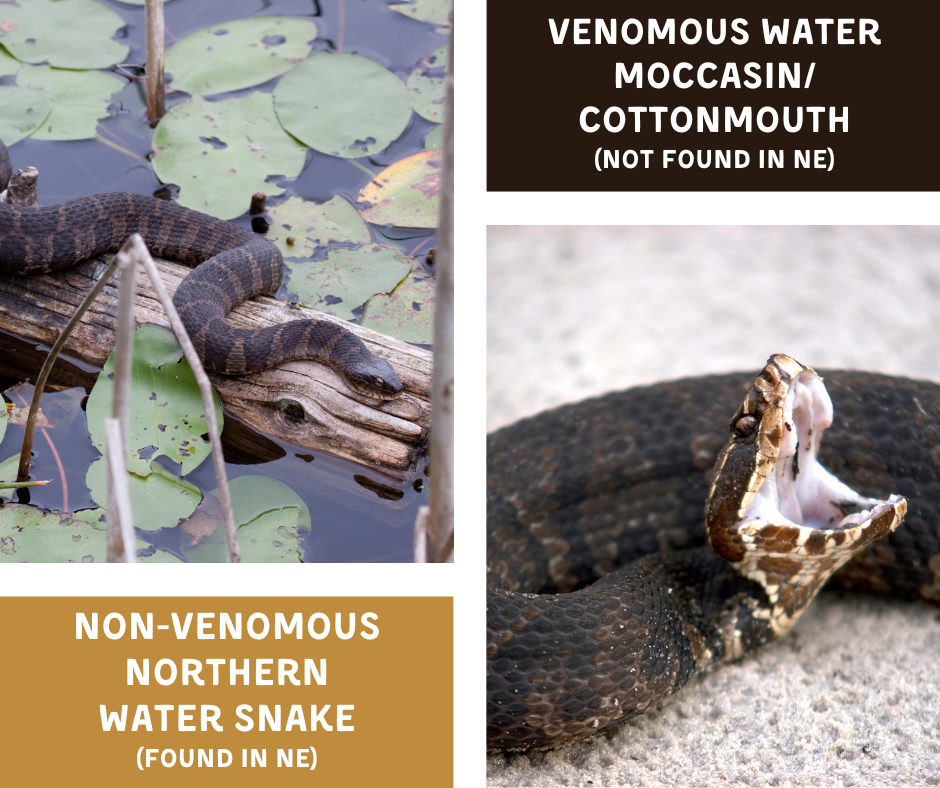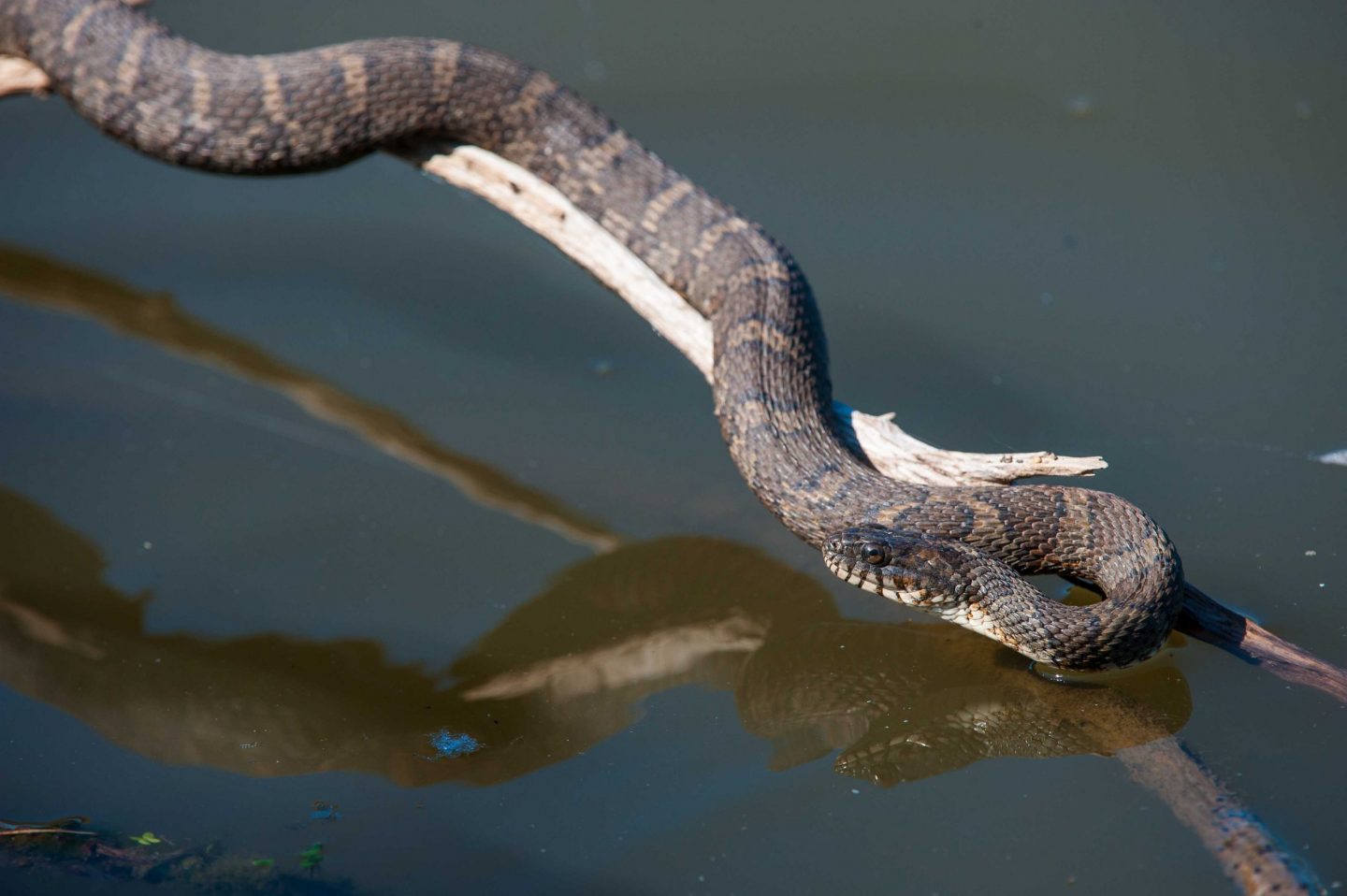
By Monica Macoubrie, Wildlife Education Specialist
If you spend enough time along Nebraska’s lakes, rivers or wetlands, you’ll likely spot a long, dark snake gliding effortlessly across the surface or coiled on a sunny bank. Chances are, it’s a northern water snake (Nerodia sipedon) — and the odds are even higher that someone nearby will immediately call it a “water moccasin” or “cottonmouth.”
Let’s bust this myth: Cottonmouths don’t live in Nebraska. What we do have are northern water snakes, which are completely nonvenomous, totally native and important to our ecosystems.
Life by the Water
Northern water snakes are true to their name. They spend nearly all their time around water, whether it’s a quiet farm pond, a shaded creek, a muddy riverbank or the cattail edges of a marsh. They’re built for an aquatic life: Their bodies are muscular and streamlined, and their keeled, or rough- textured, scales help them move smoothly through both water and vegetation. Watching one slide from a sun-warmed rock into the water is like watching liquid slipping into liquid — they vanish with barely a ripple.
These snakes aren’t just good swimmers — they’re athletes. They can climb low branches to bask above the water, wedge themselves into rock crevices to hide from predators, and even hunt while partially submerged.
What do they eat? The better question is: What don’t they eat? Northern water snakes are opportunistic feeders, meaning they’ll take whatever they can overpower. Fish make up a large portion of their diet, from small minnows to unlucky sunfish to catfish fry. They’re also quick to snatch up frogs and tadpoles, and they won’t pass up a tasty salamander or crayfish.
If the opportunity arises, northern water snakes also will go after mice or young muskrats that wander too closely to shore. They swallow their prey whole using backward-pointing teeth to hold on while their flexible jaws do the rest. By preying on so many different species, northern water snakes help keep aquatic ecosystems balanced. They prevent any one population — like frogs or small fish — from exploding in numbers, which in turn helps protect water quality and the fragile web of life in these habitats.
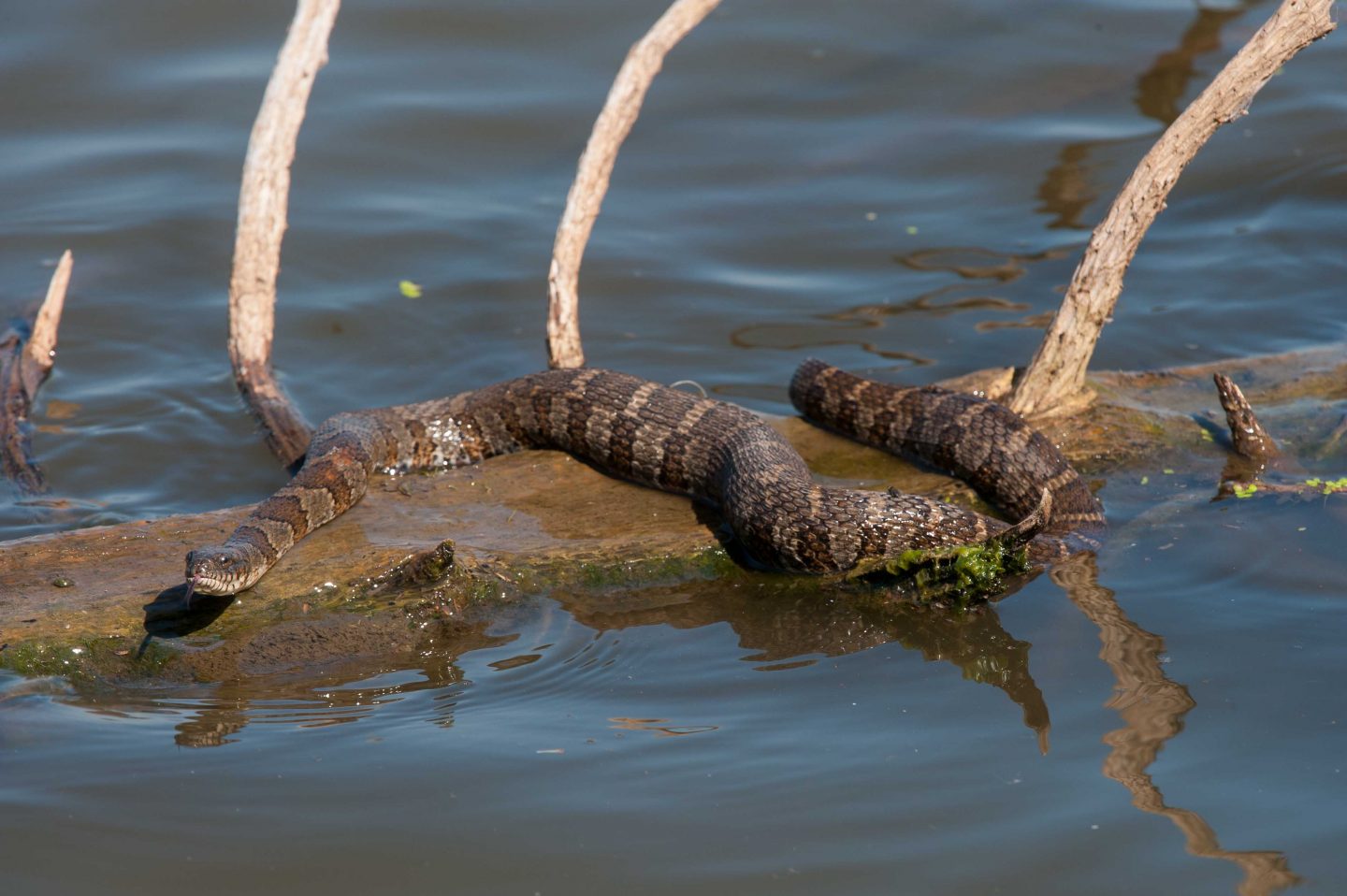
Live Birth, No Eggs!
One of the northern water snake’s most fascinating adaptations is their ability to give live birth instead of laying eggs. This adaptation, called ovoviviparity, means females carry the eggs inside their bodies until the babies are fully developed and ready to be born — usually in late summer or early fall. This strategy protects the eggs from being eaten by predators or washed away by floods, and it gives the newborns a head start on survival.
Water snakes can have anywhere from 10 to 30 tiny, fully formed young in a single litter, each ready to swim and hunt from the moment they hit the water. Combined with their strong swimming ability, excellent camouflage and defensive behaviors, this live-bearing trait helps northern water snakes thrive in Nebraska’s waterways year after year.
The Misunderstood Water Neighbor
Because they’re dark, thick-bodied, and not shy about standing their ground, northern water snakes often get labeled as “dangerous” — a reputation they don’t deserve. Their color doesn’t help their case: most are brown, gray or reddish with darker bands or blotches that can look almost black when wet. To the untrained eye, that can resemble a cottonmouth. Consequently, a lot of harmless snakes are unfairly accused and, sadly, often killed on sight.
When they feel threatened, northern water snakes employ an arsenal of defensive tricks. The most obvious one is the bluff. They’ll flatten their heads and bodies, which makes them look broader, almost like a triangle-headed venomous snake. They’ll also hiss loudly and sometimes strike toward the threat without actually trying to bite, hoping to scare off whatever’s bothering them. From their perspective, they’re not “acting mean” — they’re simply trying to look like something not worth messing with.
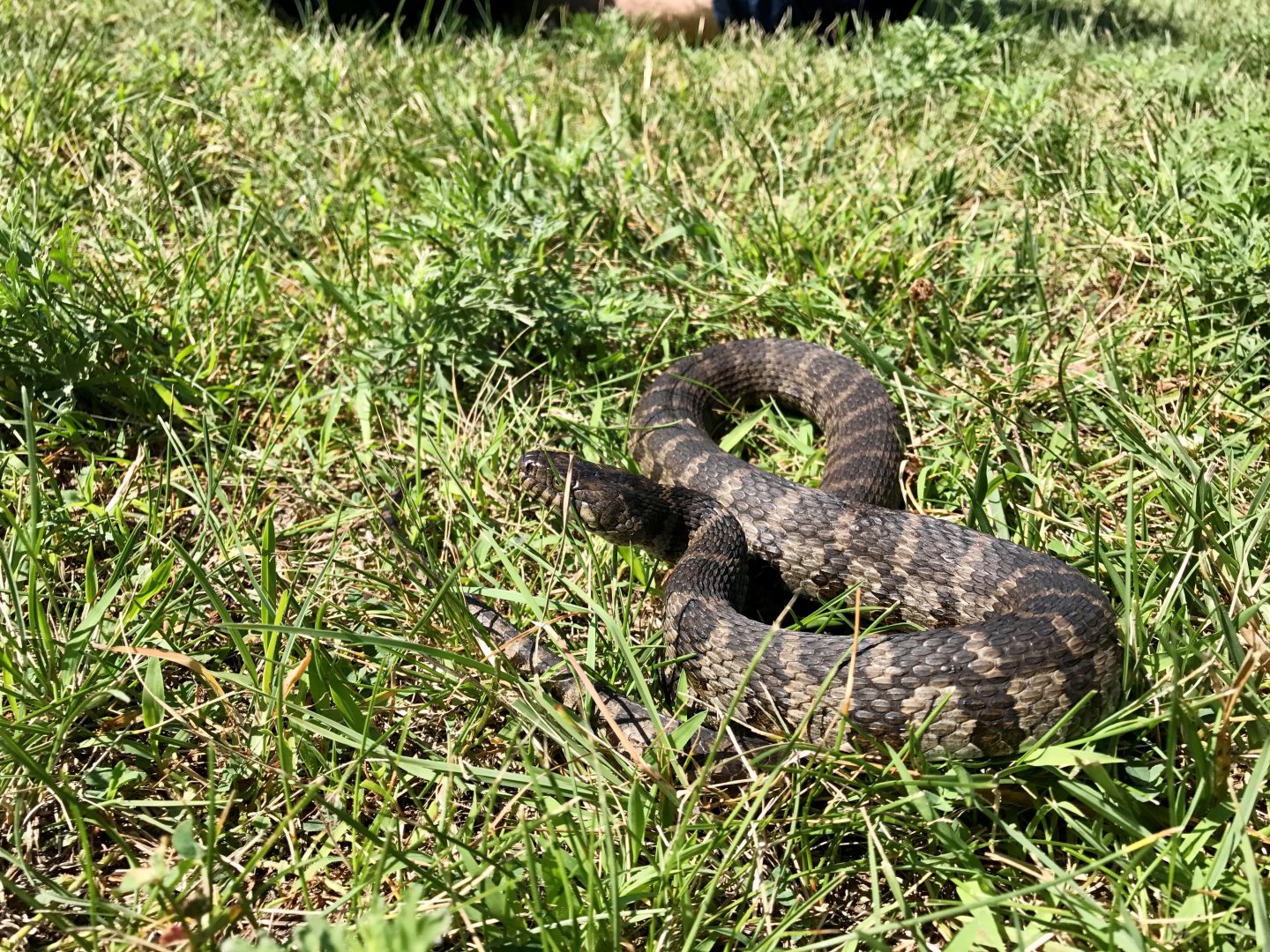
And if all that bluffing doesn’t work? They’ll bite. And bite. And bite again. These snakes don’t have venom, but they do have dozens of tiny, needle-sharp teeth that can leave your hand looking like you lost a fight with a blackberry bush. Their saliva contains a mild anticoagulant, which means their bites tend to bleed more than you might expect — it looks dramatic, but it’s not dangerous.
If you really push their buttons, northern water snakes have one final, stinky trick up their sleeve: musk. When threatened, they can release a foul-smelling liquid that seeps into your clothes and seems impossible to wash out. A lot of people assume this musk is just snake poop, but that’s not quite true. While both musk and feces exit from the same opening —the cloaca — they’re different substances. Musk comes from specialized scent glands, while feces is simply the digested leftovers of their last meal.
Note that northern water snakes don’t chase people. They’re not out to pick fights on riverbanks. Every display — the flattening, the hissing, even the biting — is about one thing: Convincing you to back off so they can get away. When left alone, these snakes prefer to slip quietly into the water and vanish.
When Water Snakes Board Your Boat
If you spend enough time paddling or fishing, you might eventually spot a northern water snake climbing onto a kayak, canoe or even a boat dock. While this can make your heart skip a beat, the snake isn’t “attacking” or trying to hitch a ride — it’s simply looking for the easiest way out of the water. Like us, snakes can get tired after a long swim and will seek out the nearest solid surface to rest and warm up. Boats, docks and even the sides of kayaks make convenient “logs” in their eyes. Once they’ve caught their breath or warmed up a bit, they usually slip back into the water on their own.
The best thing you can do is stay calm, give the snake a little space and avoid splashing or swatting. It’s not looking for trouble — just a moment to bask before moving on.
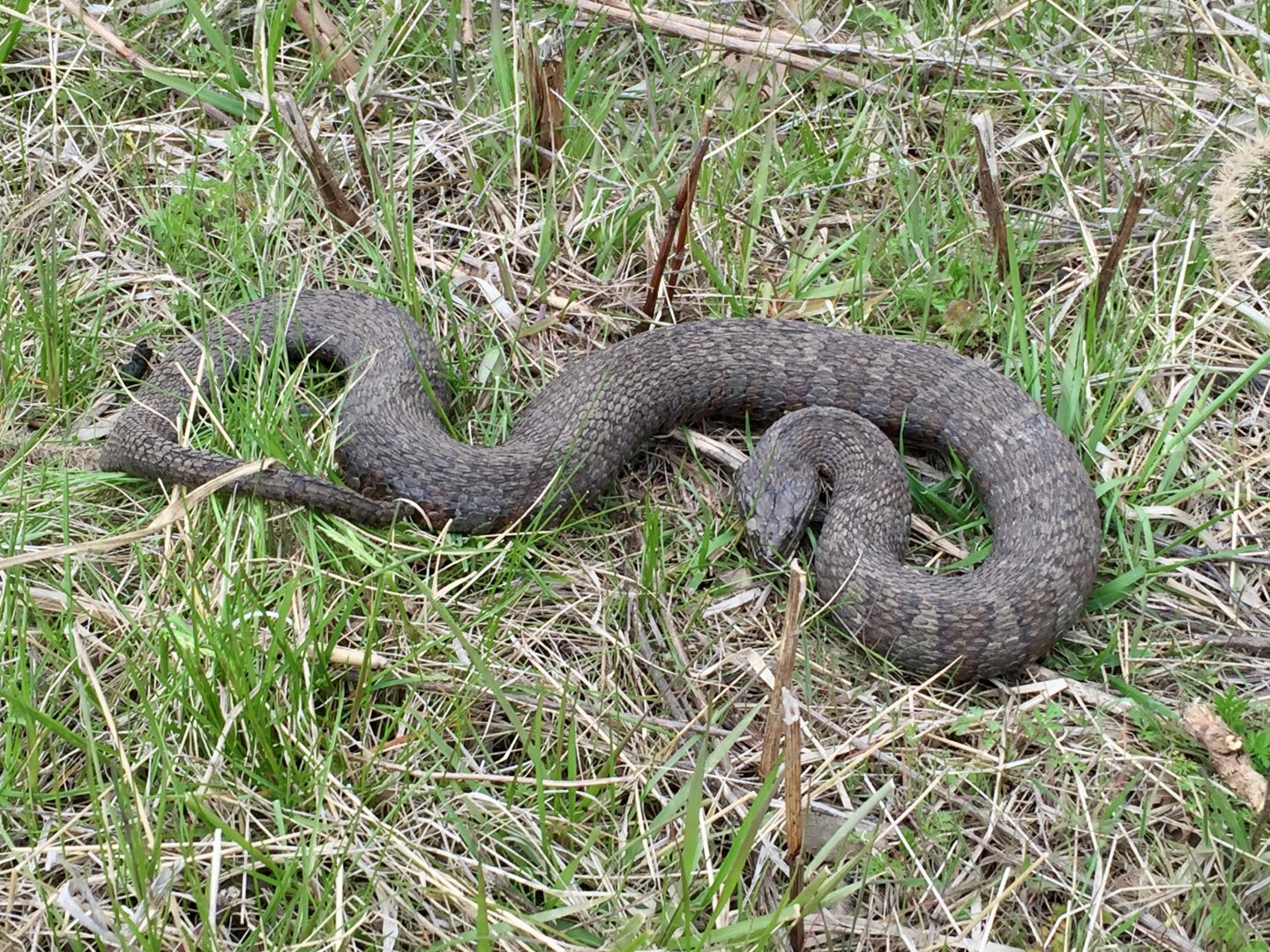
Water Moccasin vs. Northern Water Snake
It’s easy to see why people mistake the northern water snake for the water moccasin, also called cottonmouth.
Northern water snakes have slender bodies with round pupils and a narrow, more oval-shaped head that blends smoothly into their neck, while cottonmouths have stockier, heavier bodies and a distinct blocky triangular head.
Color can be tricky — both can have dark bands — but cottonmouths tend to have wider, “chunkier” bands and a more uniform, dull tone as they age, often turning nearly solid brown or black.
Another giveaway? Cottonmouths have that famous “cotton-white” mouth lining they flash when threatened, while northern water snakes don’t have that dramatic display.
And here’s the most important clue that Nebraskans should remember — cottonmouths simply aren’t found in the state.
